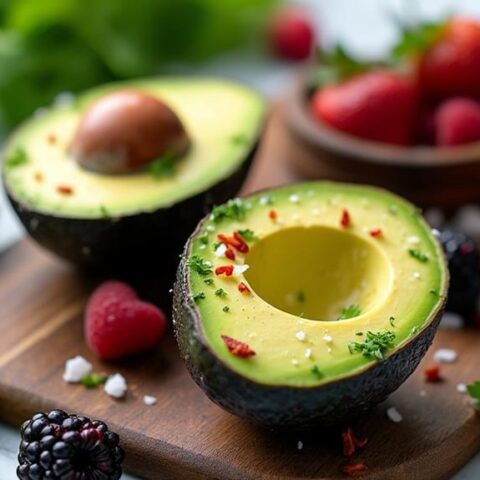
While Paleo naturally contains fewer carbohydrates than standard diets, it differs fundamentally from low-carb approaches. The Paleo diet focuses on food quality and ancestral eating patterns, allowing 100-250 grams of carbs daily from natural sources like fruits and sweet potatoes. In contrast, low-carb diets strictly limit carbohydrates to under 130 grams per day. Understanding these distinct approaches helps determine which dietary strategy best aligns with individual health goals and lifestyle preferences.
Key Takeaways
- Paleo isn't inherently low-carb, allowing 100-250g daily carbs from natural sources like fruits and starchy vegetables.
- Low-carb diets strictly limit carbohydrates to under 130g daily, while Paleo focuses on food quality rather than counting.
- Both diets eliminate processed foods, but Paleo permits more carbohydrate sources including sweet potatoes and fruits.
- Paleo excludes grains and legumes based on evolutionary principles, while low-carb restricts carbs primarily for metabolic benefits.
- Paleo offers more flexibility in carbohydrate consumption, whereas low-carb diets require strict tracking to maintain specific macronutrient ratios.
Understanding the Basics of Paleo and Low-Carb Diets
While both the Paleo and low-carb diets have gained significant popularity in recent years, understanding their fundamental differences and similarities is essential for making informed dietary choices.
The paleo diet focuses on unprocessed foods that mirror what our ancestors ate, eliminating grains and processed sugars while emphasizing fruits and vegetables as primary carbohydrate sources.
Following our ancestors' blueprint, the Paleo diet embraces whole foods while shunning grains and refined sugars, letting nature's bounty fuel us.
Low-carb diets, in contrast, specifically target carbohydrate intake reduction, often with stricter limitations on overall carb consumption.
Though not explicitly designed as a low-carb regimen, the Paleo diet naturally results in lower carbohydrate intake due to its food restrictions.
The key distinction lies in their approach to macronutrient breakdown, with low-carb diets enforcing specific ratios, while the Paleo diet emphasizes food quality and permits more flexibility in healthy fats and protein consumption.
A significant aspect of low-carb diets, such as Keto, is the induction of ketosis, a metabolic state characterized by fat utilization for energy, which is not a primary focus of the Paleo diet.
The Philosophy Behind Paleo Eating
The philosophy behind the Paleo diet emerges from a fundamental belief that modern human bodies remain genetically adapted to the diet of our pre-agricultural ancestors. This nutritional approach stems from the understanding that human genetics haven't greatly changed since the Paleolithic era, leading to three core principles:
- Eliminate grains, legumes, and processed foods that weren't available to hunter-gatherers.
- Focus on nutritious whole foods that mirror ancestral eating patterns.
- Prioritize natural, unprocessed ingredients for ideal health benefits.
Unlike strict daily carbohydrate restrictions found in other diets, the Paleo diet encourages consuming carbohydrates from natural sources like fruits and vegetables.
This philosophy emphasizes quality over quantity, suggesting that modern diseases and health issues stem from the agricultural revolution's dramatic shift in human dietary patterns.
Breaking Down Low-Carb Diet Principles
Understanding low-carb diet principles requires examining specific carbohydrate restrictions and their impact on daily nutrition. Typical Low Carb diets restrict carb intake to under 130 grams daily, while focusing on nutrient-dense alternatives and promoting flexibility in food choices. While both approaches emphasize whole food consumption, they differ in their fundamental structure. Low Carb diets primarily target carbohydrate reduction through careful tracking, whereas Paleo focuses on food quality and ancestral eating patterns. This distinction allows for varying levels of carbohydrate consumption within the Paleo framework, particularly through fruits and starchy vegetables. On a keto diet, it is crucial to avoid refined carbohydrates, sugary foods and drinks, and certain processed snacks to maintain ketosis effectively.
Carbohydrate Content in a Typical Paleo Diet
While the Paleo diet includes carbohydrates primarily from natural sources like sweet potatoes, squash, and various fruits, it differs from strictly low-carb diets by not imposing specific carbohydrate limits.
A typical Paleo diet can contain anywhere from 100 to 250 grams of carbohydrates daily, depending on individual food choices and portion sizes.
Rather than focusing on carbohydrate counting, the Paleo approach emphasizes the quality of food sources and overall nutrient density, allowing followers to consume higher amounts of carbs from whole, unprocessed foods.
Natural Carb Food Sources
Since adherents of the Paleo diet focus on whole, unprocessed foods, their carbohydrate intake primarily derives from natural sources like fruits, vegetables, nuts, and seeds.
These nutrient-dense sources provide healthy carbs while maintaining daily carbohydrate intake between 100g to 150g, considerably lower than standard dietary patterns.
The Paleo diet emphasizes these natural sources of carbohydrates:
- Fruits: Especially berries and other low-glycemic options
- Vegetables: Both non-starchy and starchy varieties, including sweet potatoes
- Nuts and Seeds: Providing complex carbohydrates along with healthy fats
Daily Carb Intake Ranges
The carbohydrate content in a typical Paleo diet naturally falls between 100 to 150 grams per day, positioning it in a moderate-carb range compared to other dietary approaches. This daily intake level distinguishes it from strict low carb diets like Keto, which limits carbohydrates to 20-50 grams daily.
While the Paleo diet doesn't impose specific carb restrictions, its focus on whole foods naturally leads to lower carbohydrate consumption than standard diets rich in processed foods.
The diet derives its carbs primarily from nutrient-dense sources like fruits and starchy vegetables, with individual intake varying based on food choices. This flexibility allows followers to adjust their carb intake while maintaining the diet's core principle of avoiding grains and legumes, making it adaptable to different nutritional needs.
How Paleo and Low-Carb Approaches Differ
Despite sharing some common principles, Paleo and low-carb diets differ considerably in their approach to carbohydrate consumption and overall food flexibility.
While both emphasize whole foods, the Paleo diet offers more latitude in food choices and doesn't require strict carbohydrate tracking.
Key differences between these dietary approaches include:
- The Paleo diet permits higher carbohydrate intake from fruits and starchy vegetables, while low-carb diets typically restrict carbs to under 130g daily.
- Low-carb diets require careful macronutrient tracking, whereas the Paleo diet focuses on food quality rather than strict counting.
- Paleo allows for a broader range of carbohydrate sources, including certain legumes and starchy vegetables that are often restricted in low-carb protocols.
This fundamental difference in flexibility makes the Paleo diet more adaptable to individual preferences and lifestyle needs.
Permitted Foods and Restrictions
The Paleo diet and low-carb diets differ markedly in their permitted food choices, with Paleo focusing on whole, unprocessed foods regardless of their carbohydrate content.
While both approaches exclude processed foods and grains, Paleo allows natural sweeteners, starchy vegetables, and fruits that would typically be restricted on strict low-carb diets.
The key distinction lies in Paleo's emphasis on food quality and ancestral eating patterns rather than specific macronutrient ratios, permitting nutrient-dense carbohydrate sources that align with hunter-gatherer food choices.
Allowed Foods Comparison
While both Paleo and Keto diets emphasize whole, unprocessed foods, they differ considerably in their allowed food categories and restrictions.
The Paleo diet includes fruits, vegetables, nuts, seeds, and lean meats, maintaining a natural approach to eating without processed foods or dairy products. In contrast, the Keto diet focuses on high fat consumption while strictly limiting carbohydrates.
Key differences in allowed foods include:
- Natural sweeteners like honey are permitted on Paleo but excluded from Keto due to carb content.
- Fruits and starchy vegetables are freely consumed on Paleo but restricted on Keto to maintain low carb intake.
- High-fat dairy products are allowed on Keto but completely restricted on Paleo, reflecting their different approaches to nutrition.
Food Restrictions Breakdown
Understanding the food restrictions in both Paleo and Keto diets reveals fundamental differences in their approaches to nutrition and health.
While both eating plans prioritize nutrient-dense foods and eliminate processed foods, their specific restrictions vary considerably. The Paleo diet focuses on foods available to early humans, permitting a wider range of carbohydrate sources from fruits, vegetables, nuts, and seeds, while excluding grains, legumes, and most dairy products.
In contrast, the Keto diet's primary focus is controlling carb content, strictly limiting intake to maintain ketosis.
The key distinction lies in how these food groups are restricted. The Paleo diet's restrictions stem from historical eating patterns rather than macronutrient targets, allowing for more flexibility in carbohydrate consumption while still maintaining its core principles of whole, unprocessed foods.
Health Benefits and Weight Loss Goals
Following a Paleo diet promotes numerous health benefits and weight management advantages through its emphasis on whole, nutrient-dense foods.
Research demonstrates that eliminating processed foods and refined sugars leads to sustainable weight loss and improved overall health. The natural reduction in carb count, while not as strict as other low-carb diets, contributes to these positive outcomes.
Cutting out processed foods and refined sugars naturally reduces carbs and promotes lasting weight loss while supporting better health outcomes.
Additionally, the improved insulin sensitivity observed in the ketogenic diet can also be a benefit of following a Paleo diet, aiding in more stable blood sugar levels and reducing the risk of type 2 diabetes.
Key benefits of the Paleo diet for weight management include:
- Enhanced satiety and reduced hunger levels, making it easier to maintain caloric goals
- Improved metabolism through increased fiber and protein consumption
- Natural weight loss through the elimination of processed foods and focus on nutrient-dense alternatives
These benefits make the Paleo diet an effective approach for those seeking sustainable weight management while maintaining nutritional balance.
Macronutrient Distribution Compared
While the Paleo diet allows for flexible carbohydrate consumption ranging from 50-150 grams daily through fruits and vegetables, the Keto diet strictly limits carbs to under 50 grams to maintain ketosis. The Paleo approach focuses on food quality rather than specific macronutrient ratios, whereas Keto demands precise tracking to maintain its characteristic 70-80% fat, 20-25% protein, and 5-10% carbohydrate distribution. This fundamental difference means Paleo dieters may never achieve ketosis unless they deliberately restrict their carbohydrate intake below ketogenic thresholds, making it distinct from the consistently ketogenic state maintained on a proper Keto diet. Additionally, keto flu and adaptation symptoms can occur when beginning the Keto diet as the body transitions from utilizing glucose to fat for energy.
Typical Daily Carb Ranges
The fundamental distinction between Paleo and low-carb diets becomes apparent in their daily carbohydrate allowances, with Paleo offering considerably more flexibility in carb consumption.
While both approaches emphasize whole foods, their macronutrient distribution differs markedly regarding carbohydrate intake.
Key daily carb ranges for these diets:
- Keto diet: Strictly limits carbohydrates to under 50g per day
- Standard low-carb diets: Generally restrict intake to under 130g daily
- Paleo diet: No strict daily carb limit, often exceeding 100g depending on food choices
The Paleo diet's more flexible approach allows followers to consume higher amounts of carbohydrates from natural sources like fruits and sweet potatoes, while maintaining its focus on unprocessed foods rather than specific macronutrient targets.
Protein-Fat-Carb Balance Differences
Beyond daily carbohydrate ranges, macronutrient distribution patterns reveal significant differences between Paleo and low-carb eating approaches.
The Paleo diet offers considerable flexibility in protein-fat-carb balance, emphasizing whole foods without strict macronutrient tracking, while allowing higher carbohydrate intake from fruits and vegetables.
In contrast, the Keto diet requires precise macronutrient distribution, with 70-80% of calories from fat, 20-25% from protein, and only 5-10% from carbohydrates.
Another key distinction lies in fat sources, as Keto relies heavily on high-fat dairy products, whereas the Paleo diet's dairy exclusion leads to obtaining fats primarily from sources like avocados, nuts, and seeds.
This fundamental difference in macronutrient distribution makes Keto more restrictive and closely monitored compared to Paleo's more adaptable approach.
Impact On Ketosis Levels
Notable differences in ketosis levels emerge when comparing the macronutrient distributions of Paleo and Keto diets. While both approaches emphasize whole food sources, their impact on ketosis varies greatly due to their distinct approaches to carb intake.
The ketogenic diet's strict macronutrient distribution creates consistent ketosis through:
- Limiting carbohydrates to 5-10% of daily calories
- Maintaining fat intake at 70-80% of total calories
- Restricting daily carb consumption to under 50 grams
The Paleo diet, though potentially low carb, doesn't typically achieve the same ketosis levels due to its more flexible approach to carbohydrates from fruits, vegetables, and natural sweeteners.
Without specific macronutrient targets, Paleo followers may consume notably more carbs than needed to maintain ketosis, resulting in different metabolic outcomes.
Impact on Blood Sugar and Energy Levels
When examining blood sugar and energy levels, Paleo followers often experience more balanced and sustained energy throughout the day compared to those following strict low-carb diets. This stability stems from the diet's moderate carbohydrate intake through nutrient-dense foods like fruits, vegetables, and certain starchy options, which help maintain consistent blood sugar control.
The emphasis on whole foods in the Paleo diet naturally enhances insulin sensitivity while eliminating processed sugars and refined carbohydrates.
Unlike the restrictive nature of keto, which limits carbs to under 50 grams daily, Paleo's more flexible approach allows for varied carbohydrate consumption based on individual needs.
This flexibility, combined with the diet's focus on nutrient-rich foods, typically results in steady energy levels and improved metabolic function, potentially reducing the risk of type 2 diabetes.
Adapting to Each Dietary Approach
Moving from the effects on blood sugar, understanding the adaptation process for both dietary approaches reveals distinct differences in implementation and sustainability.
The Paleo diet offers greater flexibility in carbohydrate intake through whole foods and starchy vegetables, making it generally easier to adopt than stricter low-carb approaches.
- The Paleo diet allows for natural variation in carbohydrate consumption based on individual food choices and preferences.
- Unlike the Keto diet's strict carb limits, Paleo followers can incorporate higher-carb options while maintaining the diet's principles.
- Shifting to Paleo typically requires fewer metabolic adjustments than adapting to the significant carbohydrate restrictions of the Keto diet.
This flexibility in dietary approach makes Paleo more sustainable for many people while still promoting healthier food choices and reduced processed carbohydrate intake.
Common Misconceptions About Both Diets
Despite their shared emphasis on whole foods and natural ingredients, the Paleo and Keto diets are often misunderstood as being identical in their approach to carbohydrate restriction. Several misconceptions cloud the understanding of these dietary approaches.
While many believe the Paleo diet is strictly low-carb, it actually permits higher carbohydrate allowances from fruits, vegetables, and natural sweeteners. Unlike the Keto diet, which requires precise tracking of macronutrients to maintain ketosis, the Paleo diet offers more flexibility in food choices without strict carb monitoring. The keto diet is linked to improved cardiovascular health through its impact on cholesterol levels and blood pressure. Another common misunderstanding involves health outcomes; though both diets can support weight loss and wellness, they achieve these results through different mechanisms. The Paleo diet's acceptance of starchy vegetables and certain fruits distinguishes it from Keto's stringent carbohydrate limits.
Making the Right Choice for Your Lifestyle
Understanding the distinctions between Paleo and low-carb diets sets the foundation for making an informed lifestyle choice.
When selecting between these eating patterns, consider your individual health needs, long-term sustainability, and personal food preferences.
Key factors to evaluate when choosing between Paleo and strict low-carb diets include:
- Carb intake flexibility – Paleo allows natural carbohydrates from fruits and starchy vegetables, while low-carb diets enforce stricter limits.
- Health goals – Whether you need precise macronutrient control or prefer focusing on whole food quality.
- Lifestyle compatibility – Consider how each diet's restrictions align with your daily routine, social activities, and cooking habits.
The best choice depends on balancing these factors with your specific health objectives, ensuring the eating pattern supports your long-term wellness journey.
Scientific Research and Evidence
Scientific research reveals significant distinctions between the Paleo diet's approach to carbohydrates and traditional low-carb eating plans. Studies indicate that while the Paleo diet naturally leads to reduced carbohydrate intake compared to standard diets, it typically allows for 100-150 grams daily through whole foods sources. The ketogenic diet emphasizes a high-fat, low-carb regimen that significantly curbs appetite and promotes weight loss.
| Comparison | Paleo Diet | Very Low Carb |
|---|---|---|
| Daily Carbs | 100-150g | Under 50g |
| Food Sources | Whole fruits, vegetables | Limited produce |
| Primary Focus | Unprocessed foods | Carb restriction |
Research published in the American Journal of Clinical Nutrition demonstrates that the Paleo diet's emphasis on whole foods while eliminating processed foods can improve metabolic markers and support weight loss, without requiring strict carbohydrate limits typical of low-carb protocols.
Long-Term Sustainability Factors
While research supports the health benefits of both eating approaches, the long-term sustainability of the Paleo diet presents distinct advantages over traditional low-carb diets.
The diet's flexibility in food choices and focus on nutrient-rich whole foods contribute to better health outcomes and increased compliance over time.
Key factors that enhance the Paleo diet's sustainability include:
- Less restrictive carbohydrate allowance, permitting fruits and starchy vegetables
- Minimal requirement for strict macronutrient tracking, reducing dietary complexity
- Greater variety of whole food options, supporting diverse nutrient intake
The Paleo diet's emphasis on high-quality, nutrient-dense protein sources further supports muscle maintenance and overall health.
Health professionals note that this balanced approach to eating, centered around unprocessed foods, often leads to higher adherence rates.
The absence of rigid restrictions, combined with an emphasis on nutritious food choices, creates a framework that many individuals find manageable for sustained periods.
Combining Paleo and Low-Carb Strategies
While the Paleo diet naturally reduces carbohydrate intake through the elimination of grains and processed foods, practitioners can further align with low-carb principles by selecting lower-glycemic fruits and emphasizing non-starchy vegetables.
Successful meal planning involves strategically combining Paleo-approved proteins and healthy fats with carefully chosen carbohydrate sources, such as berries and leafy greens.
The integration of both dietary approaches can create a sustainable eating pattern that maximizes nutrient density while maintaining lower carbohydrate levels for enhanced metabolic benefits.
Making Paleo Naturally Low-Carb
Although the Paleo diet isn't inherently designed as a low-carb eating plan, its foundation of whole, unprocessed foods naturally lends itself to reduced carbohydrate consumption. By eliminating processed foods and grains, individuals following the Paleo diet automatically decrease their carbohydrate intake while increasing their consumption of healthy fats and protein-rich foods.
The Paleo diet can become naturally low-carb by:
- Emphasizing leafy greens and non-starchy vegetables as primary carbohydrate sources
- Selecting low-sugar fruits like berries while limiting higher-sugar options
- Focusing on nutrient-dense proteins and healthy fats from nuts, seeds, and quality meats
This approach allows followers to maintain moderate carbohydrate levels, typically between 100-150 grams daily, while adhering to Paleo principles and enjoying a diverse range of whole foods.
Meal Planning Success Tips
Successfully combining Paleo and low-carb approaches requires strategic meal planning that maximizes nutritional benefits while maintaining dietary compliance. The key lies in prioritizing whole foods while carefully selecting lower-carb options that align with both dietary principles.
Effective meal planning begins with selecting quality protein sources like grass-fed meats and wild-caught fish, complemented by low-carb vegetables such as leafy greens, broccoli, and cauliflower.
Incorporating healthy fats from avocados, olive oil, and coconut oil guarantees sustained energy and enhanced satiety. While following these guidelines, practitioners should focus on non-starchy vegetables and moderate portions of low-sugar fruits like berries, avoiding higher-carb options that could compromise their dietary goals.
Frequently Asked Questions
Is Paleo Just Low-Carb?
Paleo principles extend beyond low-carb misconceptions, offering dietary flexibility through nutrient-dense food sources. While naturally moderate in carbohydrates, the diet emphasizes whole-food quality over macronutrient ratios for health benefits.
What Is the Downfall of the Paleo Diet?
Paleo restrictions can lead to nutrient deficiencies and limited food variety, making long-term sustainability challenging. The diet's strict rules affect social situations, while increased meat consumption raises cost implications for consistent weight loss maintenance.
What Are 5 Negatives From the Paleo Diet?
Paleo diets can lead to nutrient deficiencies, complicate meal planning, create social challenges, increase food costs, and lack long-term sustainability due to strict food restrictions that may hinder consistent weight loss efforts.
What Is the Most Successful Low-Carb Diet?
Research suggests Keto ranks highest among low-carb diets for weight loss success, while Mediterranean offers better long-term sustainability. Individual results vary based on personal adherence and metabolic response to carbohydrate restriction.
Conclusion
While Paleo and low-carb diets share some common ground, they remain distinct nutritional approaches with different foundational principles. Paleo focuses on ancestral eating patterns and food quality, while low-carb emphasizes carbohydrate restriction for metabolic benefits. Though a Paleo diet can be low-carb, it doesn't have to be. Understanding these nuances allows individuals to make informed choices that align with their health goals and lifestyle preferences.










No Comments